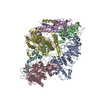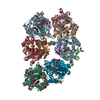+ Open data
Open data
- Basic information
Basic information
| Entry | Database: EMDB / ID: EMD-30911 | |||||||||||||||
|---|---|---|---|---|---|---|---|---|---|---|---|---|---|---|---|---|
| Title | Human 46QHuntingtin-HAP40 complex structure | |||||||||||||||
 Map data Map data | Human 46QHuntingtin-HAP40 complex structure | |||||||||||||||
 Sample Sample |
| |||||||||||||||
 Keywords Keywords | Huntingtin / 46Q / HAP40 / STRUCTURAL PROTEIN | |||||||||||||||
| Function / homology |  Function and homology information Function and homology informationvesicle cytoskeletal trafficking / : / positive regulation of CAMKK-AMPK signaling cascade / microtubule-based transport / vocal learning / negative regulation of proteasomal protein catabolic process / positive regulation of mitophagy / regulation of CAMKK-AMPK signaling cascade / profilin binding / positive regulation of cilium assembly ...vesicle cytoskeletal trafficking / : / positive regulation of CAMKK-AMPK signaling cascade / microtubule-based transport / vocal learning / negative regulation of proteasomal protein catabolic process / positive regulation of mitophagy / regulation of CAMKK-AMPK signaling cascade / profilin binding / positive regulation of cilium assembly / retrograde vesicle-mediated transport, Golgi to endoplasmic reticulum / vesicle transport along microtubule / positive regulation of aggrephagy / positive regulation of lipophagy / Golgi organization / dynein intermediate chain binding / establishment of mitotic spindle orientation / dynactin binding / phosphoprotein phosphatase activity / Regulation of MECP2 expression and activity / postsynaptic cytosol / beta-tubulin binding / presynaptic cytosol / heat shock protein binding / inclusion body / centriole / autophagosome / cytoplasmic vesicle membrane / negative regulation of extrinsic apoptotic signaling pathway / protein destabilization / kinase binding / p53 binding / late endosome / transmembrane transporter binding / early endosome / nuclear body / positive regulation of apoptotic process / axon / apoptotic process / dendrite / perinuclear region of cytoplasm / endoplasmic reticulum / Golgi apparatus / protein-containing complex / nucleoplasm / identical protein binding / nucleus / cytoplasm / cytosol Similarity search - Function | |||||||||||||||
| Biological species |  Homo sapiens (human) Homo sapiens (human) | |||||||||||||||
| Method | single particle reconstruction / cryo EM / Resolution: 3.6 Å | |||||||||||||||
 Authors Authors | Guo Q / Fernandez-Busnadiego R | |||||||||||||||
| Funding support |  Germany, European Union, 4 items Germany, European Union, 4 items
| |||||||||||||||
 Citation Citation |  Journal: Structure / Year: 2021 Journal: Structure / Year: 2021Title: Pathological polyQ expansion does not alter the conformation of the Huntingtin-HAP40 complex. Authors: Bin Huang / Qiang Guo / Marie L Niedermeier / Jingdong Cheng / Tatjana Engler / Melanie Maurer / Alexander Pautsch / Wolfgang Baumeister / Florian Stengel / Stefan Kochanek / Rubén Fernández-Busnadiego /   Abstract: The abnormal amplification of a CAG repeat in the gene coding for huntingtin (HTT) leads to Huntington's disease (HD). At the protein level, this translates into the expansion of a polyglutamine ...The abnormal amplification of a CAG repeat in the gene coding for huntingtin (HTT) leads to Huntington's disease (HD). At the protein level, this translates into the expansion of a polyglutamine (polyQ) stretch located at the HTT N terminus, which renders HTT aggregation prone by unknown mechanisms. Here we investigated the effects of polyQ expansion on HTT in a complex with its stabilizing interaction partner huntingtin-associated protein 40 (HAP40). Surprisingly, our comprehensive biophysical, crosslinking mass spectrometry and cryo-EM experiments revealed no major differences in the conformation of HTT-HAP40 complexes of various polyQ length, including 17QHTT-HAP40 (wild type), 46QHTT-HAP40 (typical polyQ length in HD patients), and 128QHTT-HAP40 (extreme polyQ length). Thus, HTT polyQ expansion does not alter the global conformation of HTT when associated with HAP40. | |||||||||||||||
| History |
|
- Structure visualization
Structure visualization
| Movie |
 Movie viewer Movie viewer |
|---|---|
| Structure viewer | EM map:  SurfView SurfView Molmil Molmil Jmol/JSmol Jmol/JSmol |
| Supplemental images |
- Downloads & links
Downloads & links
-EMDB archive
| Map data |  emd_30911.map.gz emd_30911.map.gz | 10.7 MB |  EMDB map data format EMDB map data format | |
|---|---|---|---|---|
| Header (meta data) |  emd-30911-v30.xml emd-30911-v30.xml emd-30911.xml emd-30911.xml | 15.3 KB 15.3 KB | Display Display |  EMDB header EMDB header |
| Images |  emd_30911.png emd_30911.png | 180.2 KB | ||
| Filedesc metadata |  emd-30911.cif.gz emd-30911.cif.gz | 7.4 KB | ||
| Archive directory |  http://ftp.pdbj.org/pub/emdb/structures/EMD-30911 http://ftp.pdbj.org/pub/emdb/structures/EMD-30911 ftp://ftp.pdbj.org/pub/emdb/structures/EMD-30911 ftp://ftp.pdbj.org/pub/emdb/structures/EMD-30911 | HTTPS FTP |
-Validation report
| Summary document |  emd_30911_validation.pdf.gz emd_30911_validation.pdf.gz | 458.4 KB | Display |  EMDB validaton report EMDB validaton report |
|---|---|---|---|---|
| Full document |  emd_30911_full_validation.pdf.gz emd_30911_full_validation.pdf.gz | 458 KB | Display | |
| Data in XML |  emd_30911_validation.xml.gz emd_30911_validation.xml.gz | 5.4 KB | Display | |
| Data in CIF |  emd_30911_validation.cif.gz emd_30911_validation.cif.gz | 6.2 KB | Display | |
| Arichive directory |  https://ftp.pdbj.org/pub/emdb/validation_reports/EMD-30911 https://ftp.pdbj.org/pub/emdb/validation_reports/EMD-30911 ftp://ftp.pdbj.org/pub/emdb/validation_reports/EMD-30911 ftp://ftp.pdbj.org/pub/emdb/validation_reports/EMD-30911 | HTTPS FTP |
-Related structure data
| Related structure data |  7dxjMC  7dxkC M: atomic model generated by this map C: citing same article ( |
|---|---|
| Similar structure data | |
| EM raw data |  EMPIAR-10667 (Title: Human 46QHuntingtin-HAP40 complex structure / Data size: 59.2 EMPIAR-10667 (Title: Human 46QHuntingtin-HAP40 complex structure / Data size: 59.2 Data #1: Aligned micrographs of Human 46QHuntingtin-HAP40 sample [micrographs - single frame]) |
- Links
Links
| EMDB pages |  EMDB (EBI/PDBe) / EMDB (EBI/PDBe) /  EMDataResource EMDataResource |
|---|---|
| Related items in Molecule of the Month |
- Map
Map
| File |  Download / File: emd_30911.map.gz / Format: CCP4 / Size: 15.6 MB / Type: IMAGE STORED AS FLOATING POINT NUMBER (4 BYTES) Download / File: emd_30911.map.gz / Format: CCP4 / Size: 15.6 MB / Type: IMAGE STORED AS FLOATING POINT NUMBER (4 BYTES) | ||||||||||||||||||||||||||||||||||||||||||||||||||||||||||||||||||||
|---|---|---|---|---|---|---|---|---|---|---|---|---|---|---|---|---|---|---|---|---|---|---|---|---|---|---|---|---|---|---|---|---|---|---|---|---|---|---|---|---|---|---|---|---|---|---|---|---|---|---|---|---|---|---|---|---|---|---|---|---|---|---|---|---|---|---|---|---|---|
| Annotation | Human 46QHuntingtin-HAP40 complex structure | ||||||||||||||||||||||||||||||||||||||||||||||||||||||||||||||||||||
| Projections & slices | Image control
Images are generated by Spider. | ||||||||||||||||||||||||||||||||||||||||||||||||||||||||||||||||||||
| Voxel size | X=Y=Z: 1.35 Å | ||||||||||||||||||||||||||||||||||||||||||||||||||||||||||||||||||||
| Density |
| ||||||||||||||||||||||||||||||||||||||||||||||||||||||||||||||||||||
| Symmetry | Space group: 1 | ||||||||||||||||||||||||||||||||||||||||||||||||||||||||||||||||||||
| Details | EMDB XML:
CCP4 map header:
| ||||||||||||||||||||||||||||||||||||||||||||||||||||||||||||||||||||
-Supplemental data
- Sample components
Sample components
-Entire : Human 46QHuntingtin-HAP40 complex structure
| Entire | Name: Human 46QHuntingtin-HAP40 complex structure |
|---|---|
| Components |
|
-Supramolecule #1: Human 46QHuntingtin-HAP40 complex structure
| Supramolecule | Name: Human 46QHuntingtin-HAP40 complex structure / type: complex / ID: 1 / Parent: 0 / Macromolecule list: all |
|---|---|
| Source (natural) | Organism:  Homo sapiens (human) Homo sapiens (human) |
-Macromolecule #1: Huntingtin
| Macromolecule | Name: Huntingtin / type: protein_or_peptide / ID: 1 / Details: 46Q-Huntingtin / Number of copies: 1 / Enantiomer: LEVO |
|---|---|
| Source (natural) | Organism:  Homo sapiens (human) Homo sapiens (human) |
| Molecular weight | Theoretical: 351.191312 KDa |
| Recombinant expression | Organism:  |
| Sequence | String: MATLEKLMKA FESLKSFQQQ QQQQQQQQQQ QQQQQQQQQQ QQQQQQQQQQ QQQQQQQQQQ QQQPPPPPPP PPPPQLPQPP PQAQPLLPQ PQPPPPPPPP PPGPAVAEEP LHRPKKELSA TKKDRVNHCL TICENIVAQS VRNSPEFQKL LGIAMELFLL C SDDAESDV ...String: MATLEKLMKA FESLKSFQQQ QQQQQQQQQQ QQQQQQQQQQ QQQQQQQQQQ QQQQQQQQQQ QQQPPPPPPP PPPPQLPQPP PQAQPLLPQ PQPPPPPPPP PPGPAVAEEP LHRPKKELSA TKKDRVNHCL TICENIVAQS VRNSPEFQKL LGIAMELFLL C SDDAESDV RMVADECLNK VIKALMDSNL PRLQLELYKE IKKNGAPRSL RAALWRFAEL AHLVRPQKCR PYLVNLLPCL TR TSKRPEE SVQETLAAAV PKIMASFGNF ANDNEIKVLL KAFIANLKSS SPTIRRTAAG SAVSICQHSR RTQYFYSWLL NVL LGLLVP VEDEHSTLLI LGVLLTLRYL VPLLQQQVKD TSLKGSFGVT RKEMEVSPSA EQLVQVYELT LHHTQHQDHN VVTG ALELL QQLFRTPPPE LLQTLTAVGG IGQLTAAKEE SGGRSRSGSI VELIAGGGSS CSPVLSRKQK GKVLLGEEEA LEDDS ESRS DVSSSALTAS VKDEISGELA ASSGVSTPGS AGHDIITEQP RSQHTLQADS VDLASCDLTS SATDGDEEDI LSHSSS QVS AVPSDPAMDL NDGTQASSPI SDSSQTTTEG PDSAVTPSDS SEIVLDGTDN QYLGLQIGQP QDEDEEATGI LPDEASE AF RNSSMALQQA HLLKNMSHCR QPSDSSVDKF VLRDEATEPG DQENKPCRIK GDIGQSTDDD SAPLVHCVRL LSASFLLT G GKNVLVPDRD VRVSVKALAL SCVGAAVALH PESFFSKLYK VPLDTTEYPE EQYVSDILNY IDHGDPQVRG ATAILCGTL ICSILSRSRF HVGDWMGTIR TLTGNTFSLA DCIPLLRKTL KDESSVTCKL ACTAVRNCVM SLCSSSYSEL GLQLIIDVLT LRNSSYWLV RTELLETLAE IDFRLVSFLE AKAENLHRGA HHYTGLLKLQ ERVLNNVVIH LLGDEDPRVR HVAAASLIRL V PKLFYKCD QGQADPVVAV ARDQSSVYLK LLMHETQPPS HFSVSTITRI YRGYNLLPSI TDVTMENNLS RVIAAVSHEL IT STTRALT FGCCEALCLL STAFPVCIWS LGWHCGVPPL SASDESRKSC TVGMATMILT LLSSAWFPLD LSAHQDALIL AGN LLAASA PKSLRSSWAS EEEANPAATK QEEVWPALGD RALVPMVEQL FSHLLKVINI CAHVLDDVAP GPAIKAALPS LTNP PSLSP IRRKGKEKEP GEQASVPLSP KKGSEASAAS RQSDTSGPVT TSKSSSLGSF YHLPSYLRLH DVLKATHANY KVTLD LQNS TEKFGGFLRS ALDVLSQILE LATLQDIGKC VEEILGYLKS CFSREPMMAT VCVQQLLKTL FGTNLASQFD GLSSNP SKS QGRAQRLGSS SVRPGLYHYC FMAPYTHFTQ ALADASLRNM VQAEQENDTS GWFDVLQKVS TQLKTNLTSV TKNRADK NA IHNHIRLFEP LVIKALKQYT TTTCVQLQKQ VLDLLAQLVQ LRVNYCLLDS DQVFIGFVLK QFEYIEVGQF RESEAIIP N IFFFLVLLSY ERYHSKQIIG IPKIIQLCDG IMASGRKAVT HAIPALQPIV HDLFVLRGTN KADAGKELET QKEVVVSML LRLIQYHQVL EMFILVLQQC HKENEDKWKR LSRQIADIIL PMLAKQQMHI DSHEALGVLN TLFEILAPSS LRPVDMLLRS MFVTPNTMA SVSTVQLWIS GILAILRVLI SQSTEDIVLS RIQELSFSPY LISCTVINRL RDGDSNSTLE EHSEGKQIKN L PEETFSRF LLQLVGILLE DIVTKQLKVE MSEQQHTFYC QELGTLLMCL IHIFKSGMFR RITAAATRLF RSDGCGGSFY TL DSLNLRA RSMITTHPAL VLLWCQILLL VNHTDYRWWA EVQQTPKRHS LSSTKLLSPQ MSGEEEDSDL AAKLGMCNRE IVR RGALIL FCDYVCQNLH DSEHLTWLIV NHIQDLISLS HEPPVQDFIS AVHRNSAASG LFIQAIQSRC ENLSTPTMLK KTLQ CLEGI HLSQSGAVLT LYVDRLLCTP FRVLARMVDI LACRRVEMLL AANLQSSMAQ LPMEELNRIQ EYLQSSGLAQ RHQRL YSLL DRFRLSTMQD SLSPSPPVSS HPLDGDGHVS LETVSPDKDW YVHLVKSQCW TRSDSALLEG AELVNRIPAE DMNAFM MNS EFNLSLLAPC LSLGMSEISG GQKSALFEAA REVTLARVSG TVQQLPAVHH VFQPELPAEP AAYWSKLNDL FGDAALY QS LPTLARALAQ YLVVVSKLPS HLHLPPEKEK DIVKFVVATL EALSWHLIHE QIPLSLDLQA GLDCCCLALQ LPGLWSVV S STEFVTHACS LIHCVHFILE AVAVQPGEQL LSPERRTNTP KAISEEEEEV DPNTQNPKYI TAACEMVAEM VESLQSVLA LGHKRNSGVP AFLTPLLRNI IISLARLPLV NSYTRVPPLV WKLGWSPKPG GDFGTAFPEI PVEFLQEKEV FKEFIYRINT LGWTSRTQF EETWATLLGV LVTQPLVMEQ EESPPEEDTE RTQINVLAVQ AITSLVLSAM TVPVAGNPAV SCLEQQPRNK P LKALDTRF GRKLSIIRGI VEQEIQAMVS KRENIATHHL YQAWDPVPSL SPATTGALIS HEKLLLQINP ERELGSMSYK LG QVSIHSV WLGNSITPLR EEEWDEEEEE EADAPAPSSP PTSPVNSRKH RAGVDIHSCS QFLLELYSRW ILPSSSARRT PAI LISEVV RSLLVVSDLF TERNQFELMY VTLTELRRVH PSEDEILAQY LVPATCKAAA VLGMDKAVAE PVSRLLESTL RSSH LPSRV GALHGVLYVL ECDLLDDTAK QLIPVISDYL LSNLKGIAHC VNIHSQQHVL VMCATAFYLI ENYPLDVGPE FSASI IQMC GVMLSGSEES TPSIIYHCAL RGLERLLLSE QLSRLDAESL VKLSVDRVNV HSPHRAMAAL GLMLTCMYTG KEKVSP GRT SDPNPAAPDS ESVIVAMERV SVLFDRIRKG FPCEARVVAR ILPQFLDDFF PPQDIMNKVI GEFLSNQQPY PQFMATV VY KVFQTLHSTG QSSMVRDWVM LSLSNFTQRA PVAMATWSLS CFFVSASTSP WVAAILPHVI SRMGKLEQVD VNLFCLVA T DFYRHQIEEE LDRRAFQSVL EVVAAPGSPY HRLLTCLRNV HKVTTC UniProtKB: Huntingtin, Huntingtin |
-Macromolecule #2: 40-kDa huntingtin-associated protein
| Macromolecule | Name: 40-kDa huntingtin-associated protein / type: protein_or_peptide / ID: 2 / Number of copies: 1 / Enantiomer: LEVO |
|---|---|
| Source (natural) | Organism:  Homo sapiens (human) Homo sapiens (human) |
| Molecular weight | Theoretical: 39.141879 KDa |
| Recombinant expression | Organism:  |
| Sequence | String: MAAAAAGLGG GGAGPGPEAG DFLARYRLVS NKLKKRFLRK PNVAEAGEQF GQLGRELRAQ ECLPYAAWCQ LAVARCQQAL FHGPGEALA LTEAARLFLR QERDARQRLV CPAAYGEPLQ AAASALGAAV RLHLELGQPA AAAALCLELA AALRDLGQPA A AAGHFQRA ...String: MAAAAAGLGG GGAGPGPEAG DFLARYRLVS NKLKKRFLRK PNVAEAGEQF GQLGRELRAQ ECLPYAAWCQ LAVARCQQAL FHGPGEALA LTEAARLFLR QERDARQRLV CPAAYGEPLQ AAASALGAAV RLHLELGQPA AAAALCLELA AALRDLGQPA A AAGHFQRA AQLQLPQLPL AALQALGEAA SCQLLARDYT GALAVFTRMQ RLAREHGSHP VQSLPPPPPP APQPGPGATP AL PAALLPP NSGSAAPSPA ALGAFSDVLV RCEVSRVLLL LLLQPPPAKL LPEHAQTLEK YSWEAFDSHG QESSGQLPEE LFL LLQSLV MATHEKDTEA IKSLQVEMWP LLTAEQNHLL HLVLQETISP SGQGV UniProtKB: 40-kDa huntingtin-associated protein |
-Experimental details
-Structure determination
| Method | cryo EM |
|---|---|
 Processing Processing | single particle reconstruction |
| Aggregation state | particle |
- Sample preparation
Sample preparation
| Buffer | pH: 7 |
|---|---|
| Grid | Model: Quantifoil / Material: GOLD / Support film - Material: GRAPHENE / Support film - topology: CONTINUOUS / Pretreatment - Type: PLASMA CLEANING / Pretreatment - Atmosphere: OTHER |
| Vitrification | Cryogen name: ETHANE-PROPANE |
- Electron microscopy
Electron microscopy
| Microscope | FEI TITAN KRIOS |
|---|---|
| Image recording | Film or detector model: GATAN K2 SUMMIT (4k x 4k) / Average electron dose: 60.0 e/Å2 |
| Electron beam | Acceleration voltage: 300 kV / Electron source:  FIELD EMISSION GUN FIELD EMISSION GUN |
| Electron optics | Illumination mode: FLOOD BEAM / Imaging mode: BRIGHT FIELD |
| Experimental equipment |  Model: Titan Krios / Image courtesy: FEI Company |
- Image processing
Image processing
| Startup model | Type of model: EMDB MAP |
|---|---|
| Final reconstruction | Resolution.type: BY AUTHOR / Resolution: 3.6 Å / Resolution method: FSC 0.143 CUT-OFF / Number images used: 192473 |
| Initial angle assignment | Type: PROJECTION MATCHING / Software - Name: RELION |
| Final angle assignment | Type: PROJECTION MATCHING / Software - Name: RELION |
 Movie
Movie Controller
Controller
















 Z (Sec.)
Z (Sec.) Y (Row.)
Y (Row.) X (Col.)
X (Col.)





















